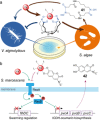Inhibitors of Bacterial Swarming Behavior
- PMID: 31268192
- PMCID: PMC7027876
- DOI: 10.1002/chem.201901961
Inhibitors of Bacterial Swarming Behavior
Abstract
Bacteria can migrate in groups of flagella-driven cells over semisolid surfaces. This coordinated form of motility is called swarming behavior. Swarming is associated with enhanced virulence and antibiotic resistance of various human pathogens and may be considered as favorable adaptation to the diverse challenges that microbes face in rapidly changing environments. Consequently, the differentiation of motile swarmer cells is tightly regulated and involves multi-layered signaling networks. Controlling swarming behavior is of major interest for the development of novel anti-infective strategies. In addition, compounds that block swarming represent important tools for more detailed insights into the molecular mechanisms of the coordination of bacterial population behavior. Over the past decades, there has been major progress in the discovery of small-molecule modulators and mechanisms that allow selective inhibition of swarming behavior. Herein, an overview of the achievements in the field and future directions and challenges will be presented.
Keywords: flagella; interactions; motility; natural products; quorum sensing.
© 2019 The Authors. Published by Wiley-VCH Verlag GmbH & Co. KGaA.
Conflict of interest statement
The authors declare no conflict of interest.
Figures











Similar articles
-
PQS Produced by the Pseudomonas aeruginosa Stress Response Repels Swarms Away from Bacteriophage and Antibiotics.J Bacteriol. 2019 Nov 5;201(23):e00383-19. doi: 10.1128/JB.00383-19. Print 2019 Dec 1. J Bacteriol. 2019. PMID: 31451543 Free PMC article.
-
Paradigm shift in discovering next-generation anti-infective agents: targeting quorum sensing, c-di-GMP signaling and biofilm formation in bacteria with small molecules.Future Med Chem. 2010 Jun;2(6):1005-35. doi: 10.4155/fmc.10.185. Future Med Chem. 2010. PMID: 21426116 Review.
-
Identification of five structurally unrelated quorum-sensing inhibitors of Pseudomonas aeruginosa from a natural-derivative database.Antimicrob Agents Chemother. 2013 Nov;57(11):5629-41. doi: 10.1128/AAC.00955-13. Epub 2013 Sep 3. Antimicrob Agents Chemother. 2013. PMID: 24002091 Free PMC article.
-
Recent progresses on AI-2 bacterial quorum sensing inhibitors.Curr Med Chem. 2012;19(2):174-86. doi: 10.2174/092986712803414187. Curr Med Chem. 2012. PMID: 22320296 Review.
-
Salt-induced Reduction of Hyperswarming Motility in Bacillus cereus MHS is Associated with Reduction in Flagellation, Nanotube Formation and Quorum Sensing Regulator plcR.Curr Microbiol. 2025 May 28;82(7):313. doi: 10.1007/s00284-025-04288-w. Curr Microbiol. 2025. PMID: 40437124
Cited by
-
Migration of surface-associated microbial communities in spaceflight habitats.Biofilm. 2023 Feb 24;5:100109. doi: 10.1016/j.bioflm.2023.100109. eCollection 2023 Dec. Biofilm. 2023. PMID: 36909662 Free PMC article.
-
Biophysical aspects underlying the swarm to biofilm transition.Sci Adv. 2022 Jun 17;8(24):eabn8152. doi: 10.1126/sciadv.abn8152. Epub 2022 Jun 15. Sci Adv. 2022. PMID: 35704575 Free PMC article.
-
Surveying a Swarm: Experimental Techniques To Establish and Examine Bacterial Collective Motion.Appl Environ Microbiol. 2022 Feb 8;88(3):e0185321. doi: 10.1128/AEM.01853-21. Epub 2021 Dec 8. Appl Environ Microbiol. 2022. PMID: 34878816 Free PMC article.
-
Characterization of strain-specific Bacillus cereus swimming motility and flagella by means of specific antibodies.PLoS One. 2022 Mar 17;17(3):e0265425. doi: 10.1371/journal.pone.0265425. eCollection 2022. PLoS One. 2022. PMID: 35298545 Free PMC article.
-
Exploring the antivirulence potential of phenolic compounds to inhibit quorum sensing in Pseudomonas aeruginosa.World J Microbiol Biotechnol. 2025 Jan 11;41(2):32. doi: 10.1007/s11274-025-04255-4. World J Microbiol Biotechnol. 2025. PMID: 39794611
References
Publication types
MeSH terms
Substances
Grants and funding
LinkOut - more resources
Full Text Sources
Other Literature Sources
Miscellaneous

